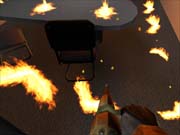Sunstorm Interactive has been at the forefront of the budget-priced 3D shooter genre since the mid-1990s, and to date it has racked up surprisingly impressive sales numbers with wantonly destructive sub-$20 affairs such as Deer Hunter, Trophy Hunter, and even Turkey Hunter. But now, with the release of the fire-fighting game 911 Fire Rescue, Sunstorm has temporarily spurned the shooting and killing that has become synonymous with first-person three-dimensional gaming. In 911 Fire Rescue, your goal is to stop the carnage rather than initiate it and save lives rather than end them. However, as well intentioned as it might be, the game feels limiting and repetitive and as such is suitable only as a fleeting diversion.

Outwardly, the 911 concept is quite intriguing. Beginning with a training exercise that places you at the site of a car fire, you'll be asked to take on a total of 17 fire-fighting missions that range from single family homes and office buildings to multiple vehicle pileups. As the game progresses, you'll face a series of increasingly stressful scenarios, each designed to accentuate speed and efficiency. Soon, you'll not only be expected to extinguish a fire, but also rescue victims, scour large mazelike environments for "hot spots," and deal with equipment shortages.
One mission may involve a massive highway pileup where your standard truck hose and its unlimited supply of water is of no use against what has become a furiously blazing fuel fire. Here, you'll be forced to drop the hose and employ the limited reserves of your foam backpack unit or your tiny vapor-charged extinguisher. Another mission might situate you inside a burning three-story office building, where the only course of action is to somehow locate a "level hose" without first being overcome by the smoke and tremendous heat that surrounds you. In this case, you'll carefully monitor the health indicator and temperature gauge at the top of the screen in order to understand what parts of your body are being impacted. Once your onscreen persona has sufficiently deteriorated, you may wish to break out the first aid kit or oxygen mask and apply a little instant relief.
If you ultimately perform above and beyond expectations, you'll soon find yourself promoted from a simple crew member to captain and right on up to fire chief. You'll also unlock the next mission and thus continue on your quest to become the greatest firefighter who ever lived. But if you fail, you'll replay the last unsuccessful mission ad infinitum until you can finally solve its mysteries. This tired old procedure of having to unlock new content is just one of 911's weaknesses.
Despite some believable and undeniably perspiration-inducing moments, the game clearly fails to deliver a realistic depiction of the true fire-fighting experience. In 911, fires do not spread, retract, or devour chunks of scenery. They do not eat through walls or collapse ceilings. In fact, they just sit there, burning at the same rate and with the same ferocity from the beginning to the end of a mission. And though some environments are totally consumed by an impressively fierce wall of flames, others merely contain little disconnected globules of fire, perhaps positioned innocently behind a computer terminal or in the middle of a roadway.
Worse still, the game forces you to seek out and eradicate every single spark before the level's time limit expires. This formula becomes particularly annoying when you've already doused 99 percent of the fire, rescued all the victims, and have no idea where in the vast maze of corridors or rooms that last spark may be. The superb source-sensitive sound of crackling flames and the telling remarks of your fireman do help somewhat, but you won't hear a thing if the last remaining embers are situated far from your current location.
Furthermore, though the actual fire fighting seems relatively authentic, most other elements do not. To rescue a victim, for instance, you'll merely locate the prone body and click the right mouse button. Voila! He or she is magically transported away from the scene. To use your oxygen mask or first aid kit, you need only click the left mouse button and wait for a moment to partially or fully recover. And because nothing ever really burns--meaning your only real nemesis is the constantly ticking clock--you're left with the distinct impression that 911 fires really aren't so bad after all.

Visually, the game runs from awesome to well below average. Certainly the bland, flat environments do little to convince you of their realism, and the water or foam that spews forth from your hoses consists almost entirely of primitively rendered white ovals. Yet the actual flames flicker and blaze in fully animated brilliance, and the thick smoke that fills many of the indoor locations is darned realistic. Unfortunately, much of the indoor world becomes prohibitively dark once the immediate danger has been extinguished, compelling you to look for a flashlight that simply isn't a part of your equipment.
But perhaps the most damning aspect of the game is its length. The first dozen missions can be completed in a single afternoon, leaving five more that challenge only because they're so damn big and their time limits are so damned short. It doesn't help that multiplayer fire fighting is not permitted either. The bargain-basement price and relatively original subject matter are definite selling points, but don't expect 911 Fire Rescue to burn brightly for more than a few hours or days.